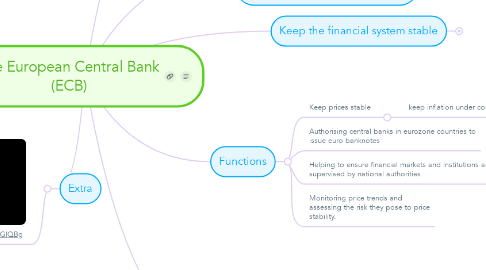The European Central Bank (ECB)
by Daniela Rangel


1. Keep the financial system stable
1.1. Task
2. To authorise the issuance of banknotes within the euro area.
3. Austria, Belgium, Finland, France, Germany, Ireland, Italy, Luxembourg, Netherlands, Portugal, and Spain
3.1. Other countries have since joined the Euro Zone including Greece, Slovakia, Slovenia, Malta, and Cyprus
4. Others Functions
4.1. the Eurosystem contributes to the smooth conduct of policies by the competent authorities as regards the prudential supervision of credit institutions and the stability of the financial system.
4.2. the ECB maintains working relations with relevant institutions, bodies and fora, both within the EU and at the global level, in respect of the tasks entrusted to the Eurosystem.
4.3. Collects statistical information necessary in order to fulfil the tasks of the ESCB.
5. Functions
5.1. Keep prices stable
5.1.1. keep inflation under control
5.2. Authorising central banks in eurozone countries to issue euro banknotes
5.3. Helping to ensure financial markets and institutions are adequately supervised by national authorities
5.3.1. Prerequisites
5.4. Monitoring price trends and assessing the risk they pose to price stability.
6. Decision-making bodies
6.1. Executive Board
6.1.1. It has 6 members
6.1.1.1. 1 president
6.1.1.2. 1 vice-president
6.1.1.3. 4 other members
6.2. Governing Council
6.2.1. Executive Board
6.2.2. The governors of the 19 national central banks in the eurozone.
6.3. General Council
6.3.1. ECB president
6.3.2. Vice-president
6.3.3. The governors of the national central banks of all 28 EU countries.
7. Extra
7.1. https://www.youtube.com/watch?v=TAlcFwGIQBg
8. History
8.1. 1998: The ECB was established in Germany.
8.1.1. The ECB formally replaced the Monetary Institute by virtue of the Maastricht Treaty

